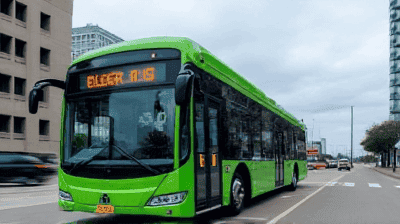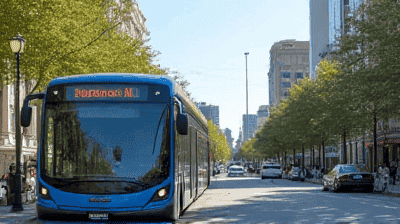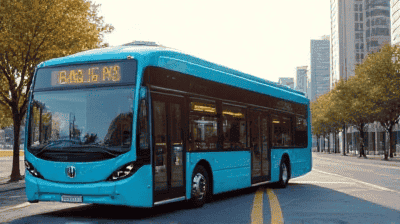
As cities around the world grapple with issues of air pollution, greenhouse gas emissions, and energy consumption, the need for sustainable public transportation solutions has never been more pressing. Among the various options available, electric buses and hydrogen-powered transit systems have emerged as two leading contenders in the race to create cleaner, more efficient public transport.
Electric buses are vehicles powered entirely by electricity stored in onboard batteries. Unlike traditional diesel buses, which emit exhaust fumes and contribute to air pollution, electric buses operate silently and produce zero tailpipe emissions. They come in various sizes, from standard transit buses to smaller shuttles, and can serve a wide range of applications, including city commuting, school transport, and long-distance travel.
Battery Electric Buses (BEBs): These buses rely solely on electric power from batteries. They need to be recharged at depots or charging stations, which can take several hours.
Trolleybuses: These buses draw power from an overhead wire system. They are typically used in urban areas with established routes and infrastructure.
Plug-in Hybrid Electric Buses: Combining electricity and a traditional fuel source, these buses can operate on electric power for shorter trips and switch to diesel or gasoline for longer journeys.
Environmental Impact: Electric buses contribute significantly to reducing greenhouse gas emissions. When powered by renewable energy sources, they can offer a truly sustainable alternative to fossil fuel-powered buses.
Operational Cost Savings: Although the initial purchase price is often higher, electric buses have lower operating and maintenance costs. They reduce fuel expenses and have fewer mechanical components, which can lead to reduced maintenance requirements.
Noise Reduction: Electric buses operate more quietly than traditional buses, contributing to improved urban soundscapes, particularly in densely populated areas.
Public Health Benefits: By eliminating tailpipe emissions, electric buses can improve air quality, resulting in better health outcomes for residents in urban areas.
Infrastructure Requirements: Charging infrastructure is vital for the successful implementation of electric bus fleets. Cities must invest in charging stations and ensure they are strategically located to support daily operations.
Range Limitations: The range of electric buses varies depending on battery capacity and usage patterns. While advancements in battery technology continue to improve range, some routes may require hybrid alternatives for longer distances.
Initial Costs: The upfront costs of purchasing electric buses and establishing charging infrastructure can be significant, often posing a challenge for transit authorities with limited budgets.
Battery Lifecycle and Disposal: The production and disposal of batteries raise environmental concerns. Recycling processes and resource extraction for raw materials create ecological impacts.

Hydrogen-powered transit, specifically hydrogen fuel cell buses, generates electricity using hydrogen as fuel. These buses convert hydrogen stored in tanks into electricity through a chemical reaction in the fuel cell, emitting only water vapor as a byproduct. Hydrogen buses provide another pathway for zero-emission public transportation and can be refueled in a matter of minutes, making them appealing for transit networks.
Electrochemical Reaction: In a fuel cell, hydrogen reacts with oxygen from the air, producing electricity, heat, and water. This reaction occurs in a fuel cell stack, where multiple cells are combined to generate the required power.
Storage and Refueling: Hydrogen is stored in high-pressure tanks within the bus. Refueling involves transferring hydrogen from a dispenser to the bus's storage tanks, similar to refueling a gasoline vehicle.
Range and Performance: Hydrogen buses typically have a longer range than battery electric buses, often exceeding 300 miles per fill-up, making them suitable for longer routes and more demanding transit tasks.
Zero Emissions: Like electric buses, hydrogen-powered transit produces no tailpipe emissions, making it an environmentally friendly option when hydrogen is produced from renewable sources.
Rapid Refueling: Hydrogen buses can be refueled in minutes, offering flexibility for transit schedules and reducing downtime compared to electric bus charging, which can take hours.
Range Advantages: Hydrogen buses can generally travel longer distances than battery electric buses on a single tank, making them suitable for routes that require higher mileage.
Scalability: Hydrogen fuel cell technology can be scaled to larger vehicles, including trucks and trains, making it a versatile option for diverse transit applications.
Hydrogen Production and Infrastructure: While hydrogen can be produced from various sources, the methods used often involve significant energy consumption and emissions, especially when produced from fossil fuels. Sustainable production methods, such as electrolysis using renewable energy, are essential for truly green hydrogen.
Storage and Distribution: Hydrogen requires specialized storage and distribution infrastructure, including refueling stations that are not yet widely available. Investment in this infrastructure is critical for enabling widespread adoption.
Cost Considerations: The current high cost of hydrogen production and fuel cell technology can deter investment and adoption. However, ongoing research and economies of scale may reduce costs over time.
Market Readiness: Hydrogen technology is still evolving, and public acceptance and awareness of hydrogen transportation technologies may take additional time to develop.
Both electric buses and hydrogen-powered transit systems aim to reduce greenhouse gas emissions and improve urban air quality. However, their environmental benefits depend significantly on the energy sources used.
Electric Buses: When charged with renewable energy such as solar, wind, or hydroelectric power, electric buses provide a clear path to zero emissions. The lifecycle emissions from battery production, however, must be considered, as well as the need for responsible recycling practices.
Hydrogen-Powered Transit: For hydrogen buses to achieve their environmental potential, hydrogen must be produced sustainably. Currently, most hydrogen is generated from natural gas, leading to carbon emissions. However, methods like water electrolysis using renewable energy sources present a cleaner alternative.
Operating Costs: Electric buses tend to have lower operating costs due to lower fuel prices and reduced maintenance requirements. Hydrogen infrastructure costs, including production, storage, and refueling, can add complexity to operating budgets.
Infrastructure Investment: While both systems require investment, electric bus deployments often involve extensive charging infrastructure, while hydrogen requires fewer refueling stations but different handling and safety protocols.
Range and Utilization: Hydrogen buses typically offer longer ranges and faster refueling times compared to electric buses. For transit agencies managing complex route networks, this could result in less downtime and increased service efficiency.
Public acceptance of both electric and hydrogen-powered transit varies based on several factors, including local policies, awareness of environmental benefits, and perceived reliability.
Electric Buses: With an increasing number of electric buses already in service globally, public familiarity with the technology is growing. Additionally, the success of programs such as electric bus trials has led to positive perceptions.
Hydrogen-Powered Transit: While hydrogen buses are still in the early adoption phase, several cities are actively testing and integrating hydrogen technology into their fleets. As awareness and technology progress, the public perception of hydrogen is likely to evolve as well.
Battery Lifecycle: Electric buses require batteries, which involve resource extraction and disposal concerns. Innovations in battery recycling are essential to minimize environmental impact over time.
Sustainable Hydrogen Production: The transition to clean hydrogen production methods will be critical. This includes significant investments in renewable energy sources to power hydrogen production via electrolysis.
Government policies and incentives play a crucial role in shaping the adoption of electric buses and hydrogen-powered transit systems.
Funding Opportunities: Greater investment in public transportation from federal, state, and local governments can drive the adoption of both technologies, offering grants, subsidies, or tax incentives to transit agencies.
Infrastructure Development: Policymakers must prioritize the creation of charging and refueling infrastructure to support electric and hydrogen bus implementations.
Many cities are actively integrating both electric and hydrogen technologies into their public transit systems, recognizing that both can coexist and serve different roles in achieving transportation goals.
Los Angeles, California: Los Angeles is testing a fleet of both electric and hydrogen fuel cell buses as part of its commitment to sustainable transit. The city aims to have a balanced approach toward clean mobility, exploring the benefits of each technology.
London, United Kingdom: London has implemented electric buses alongside hydrogen-powered double-decker buses, providing various options to meet the demands of its transit network while improving air quality.
Hamburg, Germany: Known for its progressive urban transport policies, Hamburg is piloting both electric and hydrogen buses, emphasizing the importance of emissions reductions in public transport and exploring the synergies between both technologies.

The public transport landscape is rapidly evolving. Several trends are influencing the future trajectory of electric buses and hydrogen-powered transit systems:
Innovation in battery technology continues to enhance the performance and range of electric buses. Similarly, ongoing research in fuel cell technology is improving the efficiency and cost-effectiveness of hydrogen-powered systems.
The push for renewable energy sources is likely to strengthen the case for both electric and hydrogen technologies. Integrating solar, wind, and other forms of renewable energy into public transport operations can help cities achieve their sustainability goals more effectively.
Policymakers are increasingly recognizing the importance of sustainable urban transport, leading to new regulations and incentives that encourage the adoption of electric and hydrogen-powered public transport systems.
Collaboration between public entities and private companies can accelerate the deployment of electric and hydrogen technologies in public transport. Public-private partnerships can facilitate investment in infrastructure, research, and development, and shared knowledge.
Building public awareness and support for sustainable transport initiatives is crucial. Engaging the community and informing residents about the benefits of electric and hydrogen transport options can foster acceptance and utilization.
Electric buses and hydrogen-powered transit systems are at the forefront of the transition toward sustainable public transport. Each technology offers unique advantages and challenges, but both have the potential to significantly reduce emissions, enhance urban air quality, and improve the overall efficiency of public transit.
As cities continue to evolve and work toward sustainability goals, it is likely that a hybrid approach—incorporating both electric and hydrogen technologies—will emerge. By understanding the strengths and limitations of each system, urban planners, policymakers, and transit authorities can create comprehensive transportation networks that serve diverse community needs while contributing to environmental stewardship.
The future of public transport will undoubtedly rely on innovation, investment, and a commitment to reducing car dependency. By harnessing the potential of both electric buses and hydrogen-powered transit, cities can pave the way for cleaner, greener, and more accessible urban mobility.